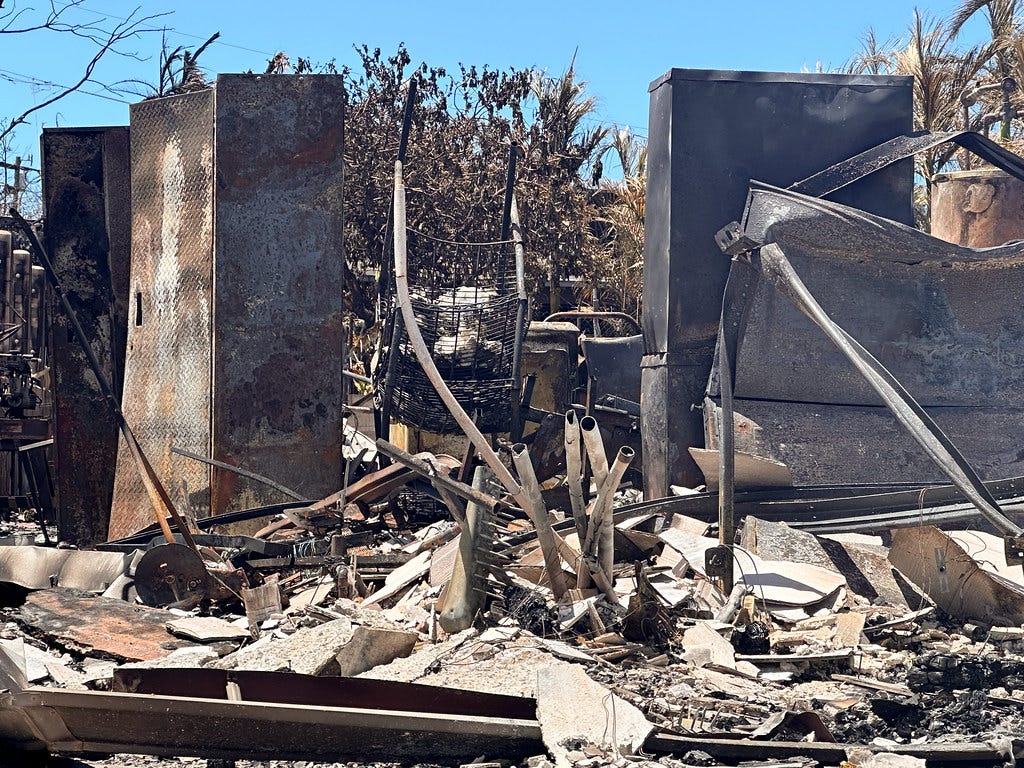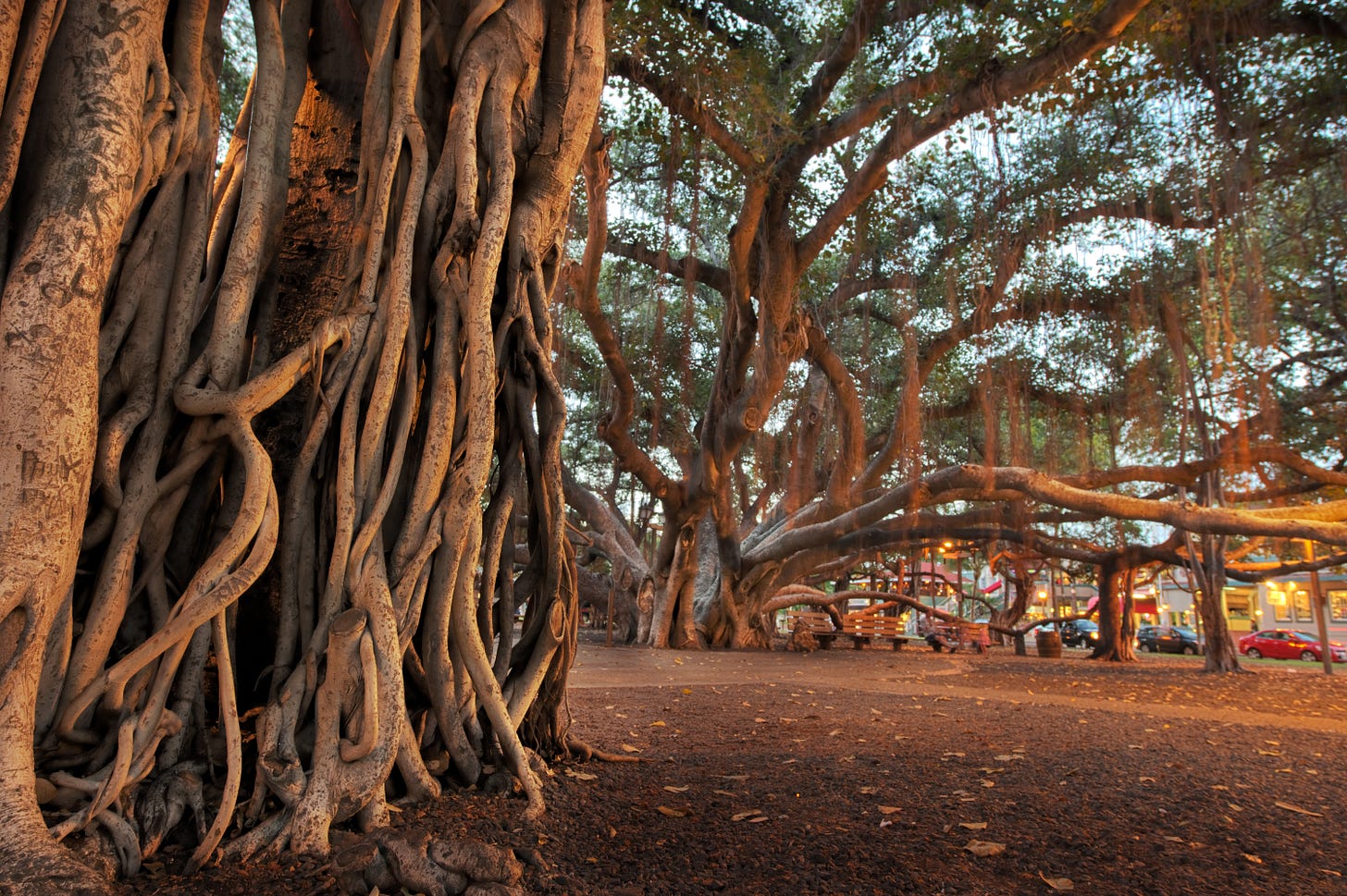fire in lahaina
Two weeks ago a devastating wildfire ripped through Lahaina, the original capital of the kingdom of Hawai'i. It’s the deadliest fire in over a century, with 115 people dead and almost 400 still missing.
As a Californian, I’m familiar with the dread of fire season, which seems to get worse and worse every year. But this was particularly shocking and horrifying.
When the Camp Fire happened in Northern California in 2018, people talked about the death, destruction, and incompetence of PG&E for years. It was considered the deadliest fire since the 1920s until the death toll in Maui – a tropical island, not a dry inland forest – surpassed it.
There is also the visceral imagery of charred cars stopped in bumper-to-bumper traffic and people seeking refuge in the Pacific Ocean. The fire in Lahaina feels dystopian, an environmental catastrophe.
It also raises a lot of questions. How does something like this happen? Is it a product of climate change? Why wasn’t it prevented? How can Lahaina recover?
I wanted to answer these questions, discuss the circumstances of the fire, and provide some resources to help the victims.
Why is there a wildfire on a tropical island?
We’re familiar with the megafires of the West ripping through California, Colorado, Texas, and even Oregon and Washington, but a fire in Hawai'i is disconcerting. Shouldn’t a tropical island be spared from fire season?
The island of Maui actually has a complicated relationship with fire. The dry side of the island (the side sheltered from rain and wind, typically by a mountain), experiences small brush fires fairly regularly. But invasive species and unusual weather conditions led to the unprecedented firestorm that engulfed Lahaina.
In the 1800s, colonizers established sugar plantations on Maui, bringing with them several species of invasive grasses, including guinea grass and buffel grass. These grasses grow rapidly during the rainy season, then desiccate during the dry season, creating the perfect fuel for wildfire.
Sugar plantations also diverted water sources for their crops, leading to long-standing tension surrounding water resources on Maui. Although the last plantation closed in 2016, tourism infrastructure still uses massive amounts of water.
This fire danger was known since 2018, when a smaller wildfire burned several homes and cars on Maui, but little action was taken to prevent future blazes.
One major difference between that fire and the one that just occurred was the weather conditions. On August 8th, Hawai'i found itself between a hurricane and an area of high pressure over the North Pacific, creating dangerous wind conditions with gusts up to 80 mph. These winds stoked the fire, turning it from a small brush fire to a deadly firestorm.
Between the invasive dry grasses and the hurricane-speed gusts, is the fire a product of climate change?
Indirectly, yes. While tropical storms aren’t abnormal for this time of year, they have become more frequent and severe as a result of climate change. Hawai'i is also 2 degrees warmer on average than it was 75 years ago – a consequence of climate change that can lead to more severe drought and reduced water resources.
Additionally, while not caused by climate change, the abundance of flammable invasive grasses is still a product of anthropogenic involvement. Colonizers altered the environment of Maui, creating the perfect conditions for a catastrophic blaze.
How did the fire start?
Regardless of the conditions, the fire had to come from somewhere.
Just after 6:30 am on August 8th, a small brush fire was reported as a result of a downed power line. Firefighters arrived quickly and by 9:00 am the fire was reported to be “100% contained.” However, around 3:30 pm the fire flared up and officials closed one of only two roads in and out of Lahaina.
Residents describe a lack of information and communication from government officials, who decided to not employ the emergency sirens often used as a tsunami warning. Some saw smoke and immediately fled, others waited for guidance, not receiving an emergency alert until almost an hour after the flareup. Some tourists were still swimming in the ocean.
By 6:00 pm, more than 12 hours after the fire was first reported, the historic district of Front Street went up in flames.
Traffic was gridlocked as people tried to escape via the narrow mountain road, and many were forced to jump into the ocean to escape the fire. Many did not escape.
What was lost?
It is impossible to quantify the damage done by the Lahaina fire – so much is gone beyond the physical structures of houses and businesses.
115 people lost their lives and nearly 400 more are still missing. 115 family members, community leaders, neighbors, and friends, gone to a fire that could have been prevented. And as the scene of the fire continues to be investigated, it is likely that number will rise.
It’s not only the staggering loss of human life – the fire ravaged livelihoods, culture, and community.
Lahaina is the original capital of the kingdom of Hawai'i, and carries tremendous cultural significance to the Kānaka Maoli, or Native Hawaiian people. One of the great losses was the Na’Aikane o Maui Cultural and Research Center, home to priceless artifacts of pre-colonial Hawai'i.
The fire took maps, books, genealogical records, and a place of connection and spirituality for local people. It also took important historical documents that are used by Native Hawaiians to fight for the right to their land.
A glimmer of hope: the beloved 150-year-old banyan tree in the heart of Lahaina is still alive, although just barely, and arborists are working tirelessly to save it. It’s a symbol of resilience for the town.
How can this be prevented in the future?
It’s clear that the Lahaina fire, while an unexpected tragedy, is the product of a series of decisions about land management, water allocation, and emergency preparedness. Fires are unpredictable and frightening and difficult to control, but unlike most natural disasters, they can be prevented.
Fire experts point to several strategies that Maui can adopt to stave off future wildfires. The first is using better evacuation technology, such as warning sirens that announce the current emergency and provide guidance on the next steps to take. Experts say cell phone alerts are not enough; it’s necessary to have multiple forms of communication.
Also important are firebreaks and vegetation management. Many other states impose requirements for homeowners to clear flammable grasses and brush from adjacent buildings, and government employees create firebreaks (intentionally clear areas near buildings and roads) to stop fires from spreading. Given the prevalence of invasive grasses on Maui, this strategy is crucial.
Fire experts also advocate for updated fire codes during the rebuilding of Lahaina. Roofs, gutters, attics, windows, and ventilation can all be constructed so that fire is less likely to destroy a house and spread to others.
In addition to local policies, Hawaiians are also calling for national support. Hawai'i has suffered under the weight of climate change, which disproportionately affects island nations, Indigenous people, and people of color. Native Hawaiians are demanding that the government impose regulations on fossil fuel consumption to help prevent future disasters, fire or otherwise.
There is also growing frustration at the tourism industry, especially after the struggle to access water during the Lahaina fire. Hawaiians fear that developers will swoop in on the devastated Lahaina, exacerbating the problem. By returning land back to the Native Hawaiians, and curbing exploitative tourism, fire danger could be significantly reduced.
How can we help?
When tragedy strikes, we should all look out for one another. It can be difficult to know the most efficacious way to provide aid, but luckily there are an abundance of resources.
Because the Lahaina fire was caused by changes to the climate and ecosystem, there are general actions we can all take to make it a safer place in the future.
Primarily, limit tourism to Hawai'i, especially now as they recover from this catastrophe. People need direct financial help, not tourism money that mostly lands in the pockets of executives. If Native people ask you not to visit, don’t visit.
It’s also important to take climate action. We can expect more environmental disasters like this to occur over the next several years and it is important to put pressure on lawmakers to divest from fossil fuels and limit the amount of loss.
To more directly aid Lahaina, here are some recommendations from a list by the Honolulu Civil Beat and a list by CBS. Consider making direct cash donations to victims of the fire. If you have any other resources or places to donate, please share in the comments below.
Hawai'i Community Foundation Maui Strong Fund
Public Schools of Hawai'i Foundation






